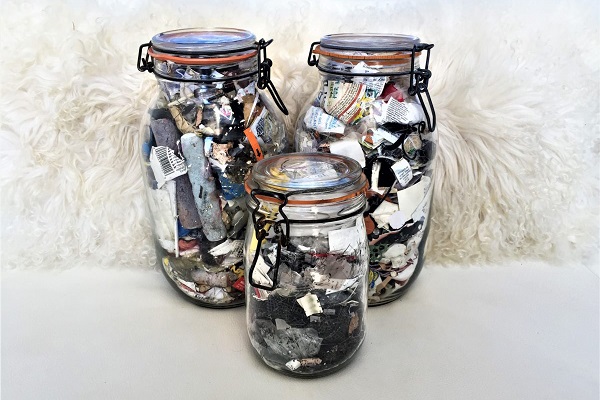EarthTalk®
From the Editors of E – The Environmental Magazine

This is all the landfill-bound trash generated by Bea Johnson’s family between 2011 and 2019. Credit: Zero Waste Home.
Dear EarthTalk: What are some quick and easy ways to make my home more comfortable and climate-friendly? — Jane B., Tampa, FL
While the coronavirus pandemic has been a serous blight on the world, we’ve all learned valuable lessons about resource consumption from running around so much less. The lack of commuting has practically emptied the roads, helping temporarily reduce carbon emissions. But all the lockdown time has also made us painfully aware of the shortcomings of our homes. Now may well be an excellent time to make improvements that will benefit not only the environment but also your residential bottom line.
One key place to start is weatherizing. If your home is drafty, you may be consuming as much as 20 percent more energy than you need to keep the inside temperature to your liking.
“One simple way to hunt for indoor leaks is to slowly move an incense stick along floors, windows, doors, vents, and walls, and look for places where the smoke changes direction rather than rising straight up,” says Daisy Simmons of Yale Climate Connections. “Jot down the trouble spots, then address them…with either weather-stripping or caulking, depending on the location.” Outlets and switches, she adds, are often draft culprits, but can be sealed easily with cheap foam gaskets from the hardware store.
Beyond remediating individual drafts, adding insulation in general (to the walls, floors, ceilings, basements and crawl spaces) can boost household energy efficiency by some 10 percent on average according to the federal government’s EnergySTAR program to promote efficient appliances and building systems. Indeed, 90 percent of homes in the U.S. are under-insulated, leaving residents vulnerable to temperature swings (cold snaps, heat waves) not to mention noise, humidity and other external negatives.
Another way to reduce your impact and carbon footprint is to cut back on the amount of garbage your household generates. Zero waste home guru and author Bea Johnson says cutting out landfill-bound trash is all about the discipline to follow five simple rules: Refuse what you don’t need (like freebies and junk mail), let go of what you don’t use or need in your home (boosting the all-important waste-busting “second-hand market”), reuse, recycle and compost. Her family has been able to reduce their annual landfill-bound waste to a few pieces of plastic and other debris that can fit into a small jar, and saves lots of money along the way. Johnson reports shaving about 40 percent off her overall family budget thanks to going zero waste.
There are tons of other ways to reduce your carbon footprint and overall environmental impact at home. Switch to cold water in the clothes washer and avoid the dryer as much as possible in favor of line-drying. Swap incandescent and even CFL light-bulbs for more efficient LEDs. Get a programmable thermostat that you can set to turn down overnight or when you’re not home. Upgrade curtains and blinds to help insulate and keep your home comfortable no matter the weather outside. With so many ways to green up your household and residential lifestyle, the hardest part might just be deciding where to start.
CONTACTS:
“Tips: How to weatherize your home;” yaleclimateconnections.org/2021/06/tips-how-to-weatherize-your-home/;
“This Jar Represents One Family’s Waste For An Entire Year,” https://www.wbur.org/hereandnow/2019/05/20/zero-waste-family.
EarthTalk® is produced by Roddy Scheer & Doug Moss for the 501(c)3 nonprofit EarthTalk. See more at https://emagazine.com. To donate, visit https//earthtalk.org. Send questions to: question@earthtalk.org
